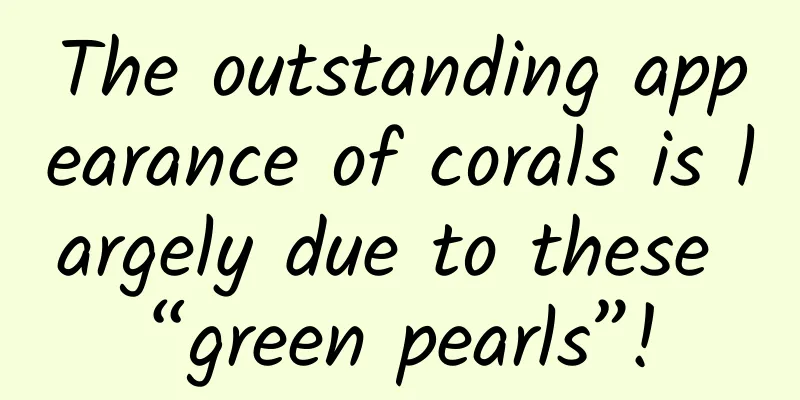The outstanding appearance of corals is largely due to these “green pearls”!

|
Zooxanthellae are yellow-brown single-celled algae that coexist with coral polyps and were discovered by Japanese biologists in the 1940s. In 1962, it was first formally proposed that zooxanthellae belong to the genus Symbiotic Dinoflagellate. Zooxanthellae are widely distributed and can be found in almost all tropical and subtropical coral reef ecosystems. From the Indian Ocean to the Pacific Ocean and then to the Caribbean Sea, in my country, they are mainly distributed along the southern coast of Fujian and the Nansha Islands. They are one of the most spectacular underwater landscapes in the world. Their existence not only enriches marine biodiversity, but also helps regulate the carbon cycle in coral reef areas and maintain the health of the entire marine ecosystem. Zooxanthellae have a unique skill - photosynthesis. Through this process, they are able to convert sunlight into chemical energy, producing sugars and oxygen. This energy conversion mechanism driven by green pigments provides corals with essential energy supplies. In return, corals supply zooxanthellae with inorganic nutrients, including carbon dioxide, phosphates, nitrogen and nitrates, which are indispensable raw materials for zooxanthellae to carry out photosynthesis. Moreover, in the process of reef-building corals and stony corals forming reefs, zooxanthellae have the effect of promoting calcification. Zooxanthellae not only provide energy to corals, but also give them rich colors. In fact, corals themselves are not naturally brightly colored; it is the pigments in zooxanthellae, such as carotene and chlorophyll, that give corals a gorgeous coat. These pigments not only attract potential mates and protect corals from UV damage, but also enhance the overall beauty of corals, making them a beautiful sight in the ocean. Zooxanthellae not only provide energy to corals, but also give them rich colors. In fact, corals themselves are not naturally brightly colored; it is the pigments in zooxanthellae, such as carotene and chlorophyll, that give corals a gorgeous coat. These pigments not only attract potential mates and protect corals from UV damage, but also enhance the overall beauty of corals, making them a beautiful sight in the ocean. Corals provide a stable living environment for zooxanthellae, a home away from external dangers. In this safe haven, zooxanthellae can photosynthesize without worrying about the risk of being devoured by predators. At the same time, the hard skeletal structure of corals also provides a physical barrier for zooxanthellae, protecting them from changes in the external environment. Bacteria play the role of intermediary and bridge in the symbiosis. They participate in the metabolic process of corals, help deal with waste, and even synthesize certain vitamins, which are essential for the growth of corals. Some bacteria also have defensive functions, fighting against pathogen invasion and maintaining the immune system of corals. However, this perfect symbiosis is not without its hidden dangers. When environmental conditions change, such as when sea temperatures rise, corals may not be able to withstand the heat stress and begin to reject the zooxanthellae in their bodies, leading to "coral bleaching". Without the zooxanthellae, corals lose their colorful luster and turn pale, becoming more susceptible to disease and environmental damage, and even eventually die. The frequent occurrence of coral bleaching events is a major warning sign of global climate change on the marine ecosystem, reminding us that we must pay attention to and protect this fragile symbiotic system. "Bacteria-zooxanthellae-coral" is a classic triangle relationship in the ecosystem, which contains complex material flow, information flow and energy flow. The balance and stability of the three are important guarantees for maintaining the health of the coral reef ecosystem. Faced with the challenges brought by global warming, the importance of protecting the symbiotic system of coral reefs and zooxanthellae has become increasingly prominent. Maintaining this fragile and precious partnership means protecting the future of the marine ecology and the well-being of countless human societies that rely on coral reef ecosystem services. Let us work together to contribute our part to this beautiful blue planet, protect every inch of coral, every tiny zooxanthellae, and jointly maintain the balance and prosperity of the earth's ecology. References [1]Xu Lintong, Zheng Yankun, Hao Jun, et al. Research progress on coral symbiotic zooxanthellae[J]. Hebei Fisheries, 2018, (08): 56-59+62. [2] Wang Tao, Cheng Keke, Cai Zhonghua, et al. Communication in the triangular relationship of “bacteria-zooxanthellae-host” in coral symbiosis[J]. Chinese Journal of Applied Ecology, 2022, 33(09): 2572-2584. [3] Lin Qiang. The story of corals and zooxanthellae[J]. Nature, 2016, (03): 30-35. [4] Zhu Xiaoou, Chen Xiaofeng. The role of zooxanthellae in coral reef construction[J]. Bulletin of Biology, 1993, (08): 19+27. |
>>: Kneading and kneading, the ancient Chinese turned mud into a national treasure
Recommend
After updating to iOS 14.2, my phone can now translate foreign websites overnight
Have you paid attention to the latest update of S...
China Automobile Dealers Association: China's imported automobile market monthly report in August 2020
Market supply From January to August 2020, the im...
Is it expensive to produce the Honghe Furniture Mini Program? Red River Furniture Mini Program Production Cost
There is no doubt that the topic of mini programs...
Zhang Xiaolong said WeChat is "decentralized". Is this a good idea?
At yesterday's WeChat open class, Zhang Xiaol...
How should an interactive landing page be designed? Teach you some tricks!
September and October are the peak decoration sea...
Advantages and disadvantages of 8 major mainstream self-media platforms and operational suggestions
This article will share with you the advantages a...
These 100 classic copywriting sentences can instantly catch your eye and make you feel excited.
Good copywriting can instantly catch the eye, gri...
The diving grandpa from Tianjin has become a hot topic on the Internet, and orthopedic doctors can’t sit still: Unscientific diving = jumping off a building!
Recently, the Tianjin diving grandpa has become p...
The 6-step core self-examination checklist for community operations, a must-read!
Through years of operational practice, I have sum...
Analyze user churn from 4 perspectives!
The author of this article, through his own proje...
Being beaten in a dream and waking up with a black eye? Revealing the terrifying interpretation of dreams!
Author: Zhou Fenli, deputy chief physician, Pekin...
Marketing promotion program skills and planning methodology
I have heard many of my friends and colleagues ta...
How to quickly start a product promotion IP on Zhihu?
I have been operating the Zhihu live streaming p...
Ps+Ai double major! The first compulsory course for designers
Ps+Ai double major! Introduction to resources for ...
How much gravity do two adults generate when standing at opposite ends of the Earth?
It takes about 1 Newton of force to lift a 100-gr...









